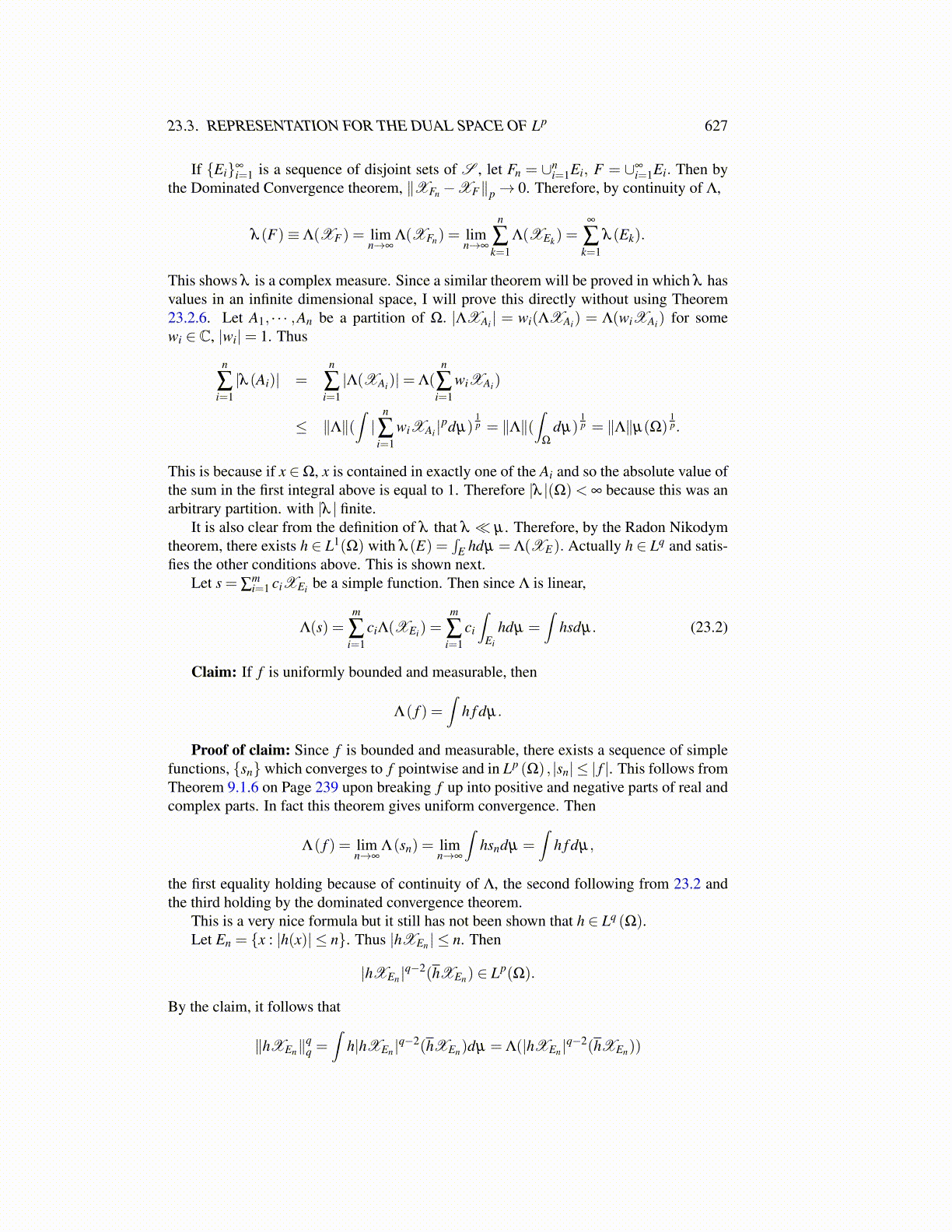
23.3. REPRESENTATION FOR THE DUAL SPACE OF Lp 627
If {Ei}∞i=1 is a sequence of disjoint sets of S , let Fn = ∪n
i=1Ei, F = ∪∞i=1Ei. Then by
the Dominated Convergence theorem, ∥XFn −XF∥p→ 0. Therefore, by continuity of Λ,
λ (F)≡ Λ(XF) = limn→∞
Λ(XFn) = limn→∞
n
∑k=1
Λ(XEk) =∞
∑k=1
λ (Ek).
This shows λ is a complex measure. Since a similar theorem will be proved in which λ hasvalues in an infinite dimensional space, I will prove this directly without using Theorem23.2.6. Let A1, · · · ,An be a partition of Ω. |ΛXAi | = wi(ΛXAi) = Λ(wiXAi) for somewi ∈ C, |wi|= 1. Thus
n
∑i=1|λ (Ai)| =
n
∑i=1|Λ(XAi)|= Λ(
n
∑i=1
wiXAi)
≤ ∥Λ∥(∫|
n
∑i=1
wiXAi |pdµ)
1p = ∥Λ∥(
∫Ω
dµ)1p = ∥Λ∥µ(Ω)
1p.
This is because if x ∈Ω, x is contained in exactly one of the Ai and so the absolute value ofthe sum in the first integral above is equal to 1. Therefore |λ |(Ω)< ∞ because this was anarbitrary partition. with |λ | finite.
It is also clear from the definition of λ that λ ≪ µ . Therefore, by the Radon Nikodymtheorem, there exists h ∈ L1(Ω) with λ (E) =
∫E hdµ = Λ(XE). Actually h ∈ Lq and satis-
fies the other conditions above. This is shown next.Let s = ∑
mi=1 ciXEi be a simple function. Then since Λ is linear,
Λ(s) =m
∑i=1
ciΛ(XEi) =m
∑i=1
ci
∫Ei
hdµ =∫
hsdµ . (23.2)
Claim: If f is uniformly bounded and measurable, then
Λ( f ) =∫
h f dµ.
Proof of claim: Since f is bounded and measurable, there exists a sequence of simplefunctions, {sn}which converges to f pointwise and in Lp (Ω) , |sn| ≤ | f |. This follows fromTheorem 9.1.6 on Page 239 upon breaking f up into positive and negative parts of real andcomplex parts. In fact this theorem gives uniform convergence. Then
Λ( f ) = limn→∞
Λ(sn) = limn→∞
∫hsndµ =
∫h f dµ,
the first equality holding because of continuity of Λ, the second following from 23.2 andthe third holding by the dominated convergence theorem.
This is a very nice formula but it still has not been shown that h ∈ Lq (Ω).Let En = {x : |h(x)| ≤ n}. Thus |hXEn | ≤ n. Then
|hXEn |q−2(hXEn) ∈ Lp(Ω).
By the claim, it follows that
∥hXEn∥qq =
∫h|hXEn |q−2(hXEn)dµ = Λ(|hXEn |q−2(hXEn))